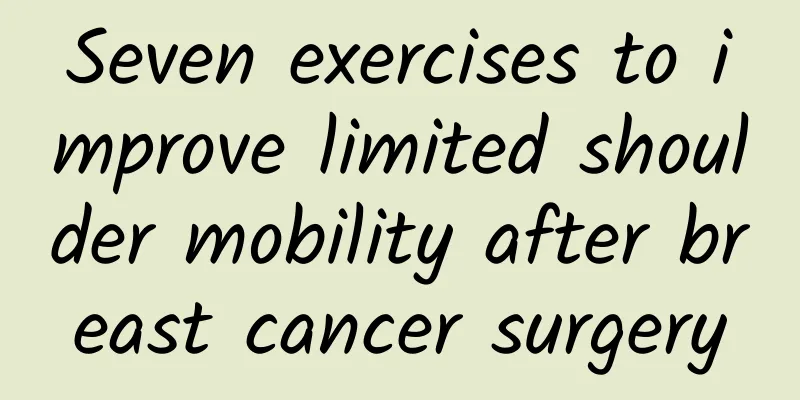Seven exercises to improve limited shoulder mobility after breast cancer surgery

|
The breast cancer surgery went smoothly, but my shoulders feel very stiff and cannot move freely. I can’t even do normal activities like combing my hair or buttoning my back. What should I do? The Importance of Shoulder Mobility Shoulder joint function plays an important role in the entire upper limb function. Its loss will lead to 60% loss of upper limb function. According to statistics, the incidence of shoulder dysfunction in patients after breast cancer surgery is 2% to 51%, which is one of the most common complications after breast cancer surgery. Limited shoulder movement directly leads to the inability to do many things in daily life, such as limited arm movement when dressing, inability to fully reach the back when bathing, difficulty lifting objects, etc. Why is there limited shoulder mobility? 1. Surgical factors There are many surgical methods for breast cancer. The operation will damage the muscles, lymph nodes and nerves around the surgical site, leading to local scar tissue formation, fibrosis and soft tissue contracture, and thus limited shoulder movement. Even if the modified radical mastectomy is less invasive and can preserve the pectoralis major and minor muscles, the probability of limited shoulder movement after surgery is still high. 2. Radiotherapy factors Shoulder joint dyskinesia is the most common complication after radiotherapy for breast cancer. According to statistics, the incidence rates are 57.6% and 65.2% in subjective symptoms and objective signs, respectively. The main reason is that preoperative and postoperative radiotherapy for breast cancer can cause venous occlusion, lymphatic vessel damage, and local muscle fibrosis in the radiation field. 3. Impact of other complications Subcutaneous effusion and skin flap necrosis will affect the patient's wound healing, forcing them to give up shoulder movement, resulting in varying degrees of shoulder joint movement restriction. Upper limb lymphedema will also affect upper limb movement, thus limiting shoulder joint movement. Seven exercises to improve limited shoulder mobility Exercise 1: Wall climbing Place your hands on the wall and climb up from the bottom. When you feel any discomfort, stop and hold for 10 seconds. Put your hands back to their original position, and then repeat this action. Try to gradually increase the angle and climb higher and higher, until you can finally reach the highest point with both hands level. Movement 2: Pendulum Movement Bend over with your arms hanging naturally, and gently shake your arms to make them swing, alternating between front and back and left and right, within the pain-free range. Start with a small swing (about 30 degrees) and then gradually increase the angle to 90 degrees. Exercise 3: Hands around shoulders Cross the fingers of both hands and hold them in front of the chest, raise the hands until the shoulders are bent forward 90 degrees, then raise them further and try to go over the top of the head, and then return to the original position. Exercise 4: Elbow lift exercise Use the affected hand to hold the elbow of the healthy side, and move in coordination with your breathing. Bend forward and raise your arm when you inhale, and lower your arm when you exhale. Repeat this process. Exercise 5: Diving start exercise Bend your hands forward and place them flat, take a deep breath and then exhale and stretch forward, stretch your back like a car body, and get ready for diving. After fully stretching, inhale, exhale and place your hands on your thighs, and straighten your body. In addition to strengthening the forward flexion of the shoulders, this action can also effectively relieve the back muscles and reduce stiffness. Exercise 6: Chest-opening exercise Stand upright, cross your hands behind your head, rotate to the right while inhaling, and return to the right position while exhaling. This movement can improve shoulder joint mobility and help open the chest, reduce pain, and improve round shoulders. Exercise 7: Side bending exercise Hold your head with both hands, bend your body to the right while inhaling, and feel the left side of your body being completely stretched out. Exhale and return to the normal position, and repeat in the opposite direction. This will improve the limited abduction of the shoulders and effectively stretch the lateral chest and back muscles. Notice: It is recommended to continue shoulder activities after the drainage tube is removed. References: [1] Duan Ranran, Zhao Zhenbiao, Huai Yaping. Research progress on rehabilitation training for common complications of upper limbs after breast cancer surgery[J]. Chinese Journal of Rehabilitation Theory and Practice, 2017, 23(09): 1007-1010. [2] Cai Zhongbo, Fang Guizhen. Research progress on influencing factors of shoulder joint dysfunction in patients after breast cancer surgery[J]. Nursing Research, 2016, 30(30): 3730-3734. Author: Yuan Mei, Bi Xia, Zhao Jiangxia About the Author Bi Xia Bi Xia, Doctor of Medicine, Chief Physician, Master Supervisor, is currently the Director of the Department of Rehabilitation Medicine, Zhoupu Hospital Affiliated to Shanghai University of Medicine and Medical Sciences, and the Vice President of the School of Rehabilitation, Shanghai University of Medicine and Medical Sciences. In 2010, 2018 and 2019, she was selected into the Excellent Discipline Leader and Leading Talent Training Program of the Health System of Pudong New Area. She has published 4 SCI papers and more than 30 core journal papers as the first author and corresponding author. Professional fields: stroke rehabilitation, fracture postoperative rehabilitation, spinal cord injury rehabilitation, artificial joint perioperative rehabilitation, hand injury rehabilitation, etc. Main academic positions: Member of the Geriatric Rehabilitation Branch of the Chinese Rehabilitation Medicine Association, Member of the Medical and Nursing Integration Committee of the Chinese Rehabilitation Medicine Association, Rehabilitation Committee Member of the Geriatric Rehabilitation Branch of the Chinese Medical Doctor Association, Executive Director of the Shanghai Rehabilitation Medicine Association, Member of the Physical Medicine and Rehabilitation Branch of the Shanghai Medical Association, Vice Chairman of the Rehabilitation Treatment Committee of the Shanghai Rehabilitation Medicine Association, Member of the Orthopedic Rehabilitation Committee of the Shanghai Rehabilitation Medicine Association, Member of the Spinal Cord Injury Rehabilitation Committee of the Shanghai Rehabilitation Medicine Association, Member of the Community Rehabilitation Committee of the Shanghai Rehabilitation Medicine Association, Member of the Sports Health and Rehabilitation Committee of the Shanghai Rehabilitation Medicine Association, Chairman of the Rehabilitation and Physiotherapy Committee of the Shanghai Pudong New Area Medical Association, and other academic positions. About the Author Yuan Mei Yuan Mei is a therapist at the Department of Rehabilitation Medicine, Zhoupu Hospital Affiliated to Shanghai University of Medicine and Health Sciences. She holds a master's degree in rehabilitation therapy and has published three rehabilitation-related papers. Specializes in postpartum rehabilitation and rehabilitation of cervical and lumbar diseases. Funded by Shanghai Science and Technology Commission's Science Popularization Project (Project No.: 20DZ2311100) |
<<: What are the dangers of hypoglycemia?
>>: What fruits are suitable for people with high blood sugar? Can insomnia cause high blood sugar?
Recommend
How many people's New Year DNA is touched by a bite of preserved meat? Stroke patients should be more careful about "delicious traps"
As the Year of the Snake approaches, bacon is a p...
Is it harmful to wash your hair during menstruation? Should you wash your hair during menstruation?
Menstruation is a very critical moment for women....
Lip Knife for the Treatment of Cervical Erosion
There are many common diseases among women, and t...
How do you get Bartholinitis?
The occurrence of Bartholin's glanditis affec...
Can I drink hawthorn tea during menstruation?
Many people like to drink hawthorn tea, which can...
Why is my period delayed and my waist is sore?
When it comes to delayed menstruation, I believe ...
Brown vaginal discharge during pregnancy
Women do not have menstruation during pregnancy, ...
These common eye diseases in spring, remember to prevent them in advance!
Spring is the season when everything comes back t...
What is the disease that causes increased leucorrhea?
Many gynecological diseases can cause an increase...
It hurts like a needle prick down there
The vagina is part of the female reproductive org...
What causes back acne during pregnancy?
Many pregnant women will develop many small pimpl...
How to maintain the endometrium?
There are certain differences in the body structu...
What causes brown discharge between periods?
As female friends, menstruation is one of the phy...
What are the ways to eat Asparagus corydalis? Why does Asparagus corydalis melt when boiled in water?
Asparagus is a very popular vegetable on the mark...
Why do women like men to hold them when they sleep?
Men and women have different personalities. Men l...









